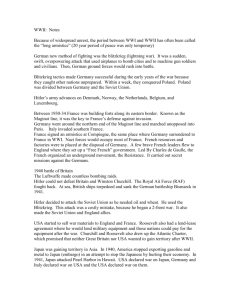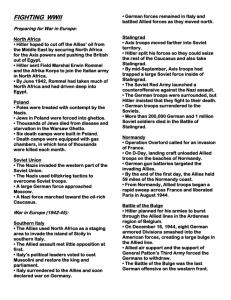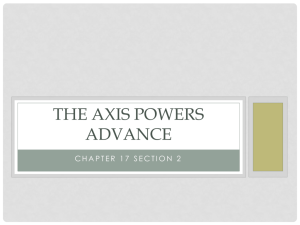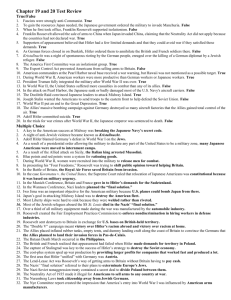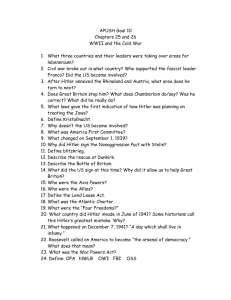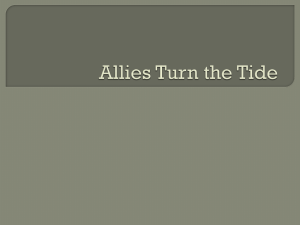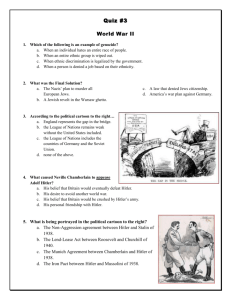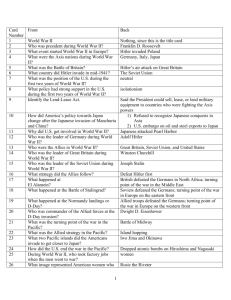World War II Section 1 Two important conferences—one in the
advertisement
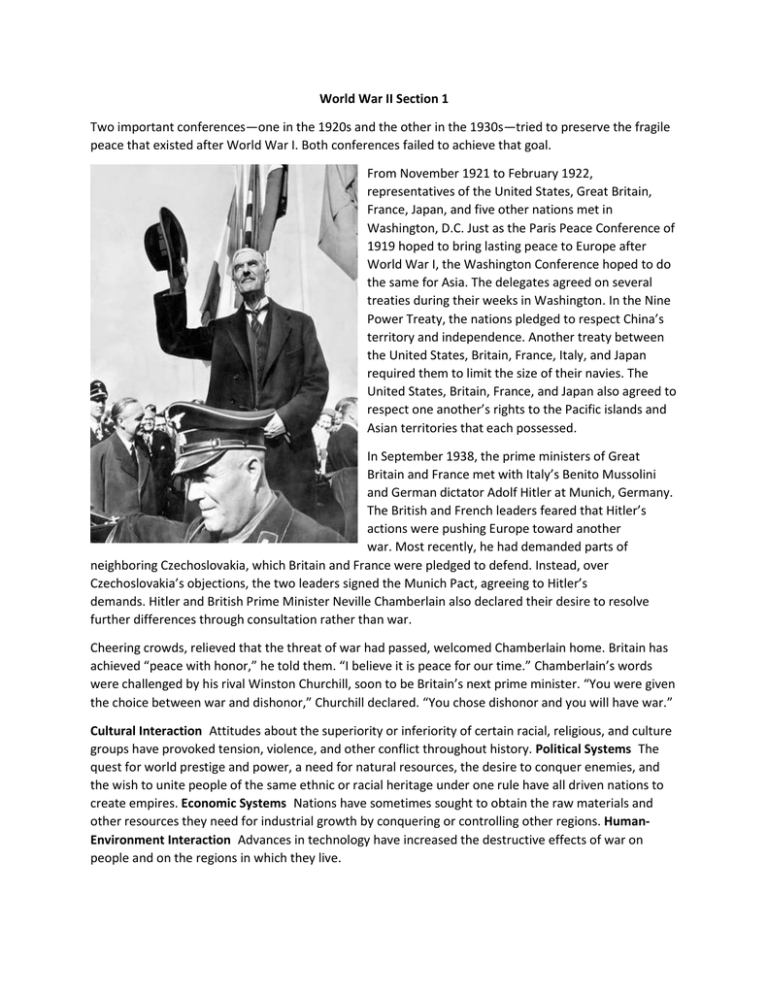
World War II Section 1 Two important conferences—one in the 1920s and the other in the 1930s—tried to preserve the fragile peace that existed after World War I. Both conferences failed to achieve that goal. From November 1921 to February 1922, representatives of the United States, Great Britain, France, Japan, and five other nations met in Washington, D.C. Just as the Paris Peace Conference of 1919 hoped to bring lasting peace to Europe after World War I, the Washington Conference hoped to do the same for Asia. The delegates agreed on several treaties during their weeks in Washington. In the Nine Power Treaty, the nations pledged to respect China’s territory and independence. Another treaty between the United States, Britain, France, Italy, and Japan required them to limit the size of their navies. The United States, Britain, France, and Japan also agreed to respect one another’s rights to the Pacific islands and Asian territories that each possessed. In September 1938, the prime ministers of Great Britain and France met with Italy’s Benito Mussolini and German dictator Adolf Hitler at Munich, Germany. The British and French leaders feared that Hitler’s actions were pushing Europe toward another war. Most recently, he had demanded parts of neighboring Czechoslovakia, which Britain and France were pledged to defend. Instead, over Czechoslovakia’s objections, the two leaders signed the Munich Pact, agreeing to Hitler’s demands. Hitler and British Prime Minister Neville Chamberlain also declared their desire to resolve further differences through consultation rather than war. Cheering crowds, relieved that the threat of war had passed, welcomed Chamberlain home. Britain has achieved “peace with honor,” he told them. “I believe it is peace for our time.” Chamberlain’s words were challenged by his rival Winston Churchill, soon to be Britain’s next prime minister. “You were given the choice between war and dishonor,” Churchill declared. “You chose dishonor and you will have war.” Cultural Interaction Attitudes about the superiority or inferiority of certain racial, religious, and culture groups have provoked tension, violence, and other conflict throughout history. Political Systems The quest for world prestige and power, a need for natural resources, the desire to conquer enemies, and the wish to unite people of the same ethnic or racial heritage under one rule have all driven nations to create empires. Economic Systems Nations have sometimes sought to obtain the raw materials and other resources they need for industrial growth by conquering or controlling other regions. HumanEnvironment Interaction Advances in technology have increased the destructive effects of war on people and on the regions in which they live. Section 2 Both Japan and Germany had a mixed history of military rule and democracy. Both also began to industrialize in the decades before World War I. However, unlike Germany, Japan lacked raw materials for its industries. Instead, it relied on a strong military to obtain them from other nations. The Rise of Militarism in Japan In the decade after World War I, Japanese aggression declined. In 1920, Japan helped form the League of Nations. It also joined many other nations in signing the KelloggBriand Pact, a 1928 agreement that condemned war. Civilians gained more power in Japan’s government, although the nation’s emperor continued to play a strong role. New political parties developed and calls were made to extend the right to vote to all people. Not all Japanese were happy with these trends. Some objected to Japan’s agreement to the treaty signed at the Washington Conference, which limited Japan’s navy to three-fifths the size of the U.S. and British navies. Many Japanese also were concerned about events at home, such as the rise of communism and socialism and other disruptive influences of Western culture. The worldwide economic depression of the 1930s further weakened Japan’s democracy. Japanese leaders began to believe that expansion through conquest would solve Japan’s economic problems. This belief moved Japan toward a policy of militarism. The military began to play a greater role in Japanese politics and government. Japanese militarism was combined with extreme nationalism. Radical nationalists called for more aggressive military action abroad to acquire territory and raw materials. When Japan’s prime minister tried to stop such plans, a group of naval officers killed him in 1932. Army troops carried out more political assassinations in 1936. Politicians, fearing for their lives, gave up more power to the military. Militarists Expand Japan’s Empire Japan and other imperialist powers had long held spheres of influence in China. Japan’s sphere of influence was in Manchuria, a region in northeastern China that was rich in natural resources. In 1931, Japan’s army seized the entire region. When the League of Nations pressured Japan to return Manchuria to China, Japan refused and withdrew from the League. Instead, Japan turned Manchuria into an industrial and military base for its expansion into Asia. More aggression followed as Japan grew stronger and the military gained control of its government. In 1936, Japan withdrew from the naval limitation treaty it had signed at the Washington Conference. In 1937, Japanese troops clashed with Chinese forces outside Beijing, China’s capital. Japanese forces quickly took Beijing and then pushed south against sometimes fierce Chinese resistance. After capturing the city of Nanking (known today as Nanjing), Japanese soldiers went on a six-week rampage known as the Rape of Nanking. They massacred more than 100,000 Chinese civilians and brutally raped about 200,000 Chinese women. By 1939, Japanese forces controlled most of northern and eastern China, including its main cities and industries. By 1941, Japan had added French Indochina to its Asian empire to go with Formosa (now called Taiwan), Korea, large areas of China, the southern half of Sakhalin Island, and several small Pacific islands. Testing the League of Nations Japan’s aggression tested the League of Nations. The League was intended to serve as an instrument of international law. In theory, it could impose boycotts and other economic sanctions or use the combined military force of its members to keep unruly nations in line. In practice, however, it was a weak organization, in part because the United States was not a member. The League failed to respond effectively to Japan’s challenge. Throughout the 1930s, Germany and Italy also tested the League’s will. Like Japan, Germany pulled out of the League of Nations in 1933. At the same time, Hitler began rebuilding the German military. In 1935, he announced the formation of an air force and the start of compulsory military service. Both actions were in violation of the Treaty of Versailles. Hitler’s violation of the treaty boosted his popularity in Germany. The League of Nations lodged a formal protest, but it refused to consider sanctions against Germany. The next year, Hitler challenged France and the League by sending troops into the Rhineland, which the Treaty of Versailles had stripped from Germany and placed under international control. This was another test of the League’s resolve to stand up to aggression. Meanwhile, Mussolini began his quest to build a New Roman Empire. In October 1935, the Italian army invaded the African nation of Ethiopia. The poorly equipped Ethiopian forces could not stop the invaders. Ethiopia appealed to the League of Nations, which voted to impose economic sanctions on the aggressor. The sanctions were mild, and few League members seriously applied them. In May 1936, Italy officially annexed Ethiopia. Hitler heartily approved of the invasion. In October, he and Mussolini joined in a treaty of friendship that forged an alliance, known as the Rome–Berlin axis, between their countries. Because of this alliance, Germany and Italy were called the Axis Powers. Britain and France Appease Hitler Encouraged by events in Italy and Spain, and by his own successful occupation of the Rhineland, Hitler continued his campaign of expansion. During this time, Great Britain and France did little to stop him, choosing instead to follow a policy of appeasement. Hitler next set his sights on neighboring Austria, the country of his birth. At the time, Austria had an unstable government with fascist elements. Hitler pressured its leaders to join the German Reich, or “empire.” Hitler issued an ultimatum to the Austrian chancellor: he could hand over power to the Austrian Nazis or face an invasion. He handed over power to the Nazis. Nevertheless, Hitler’s army invaded anyway, crossing the border into Austria without opposition on March 12. The next day he proclaimed Anschluss, or “political union,” with Austria. Great Britain and France remained spectators to this German expansion. Hitler claimed that he wanted to bring all ethnically German areas in Eastern Europe back into the German Reich. By signing the Munich Pac tin September 1938, he acquired the Sudetenland, a Germanspeaking region of Czechoslovakia. He told Chamberlain that this would be his “last territorial demand.” Just six months later, however, Hitler revealed that he wanted more than to bring all ethnic Germans into the German Reich. In March 1939, he annexed Bohemia, an ethnically Czech region. When Britain and France failed to act, Mussolini invaded nearby Albania in April 1939. It took just a few days to conquer this small nation across from Italy on the Adriatic Sea. U.S. Neutrality Like Great Britain and France, the United States did little to thwart Japanese, German, and Italian aggression. When Mussolini invaded Ethiopia, for example, the League of Nations considered an oil embargo against Italy. With no fuel, the Italian army’s offensive would have ground to a halt. The League asked the United States, a major oil supplier, if it would join the embargo. President Franklin D. Roosevelt refused, pointing out that he had just signed the Neutrality Act of 1935. This act prevented the United States from supplying “arms, ammunition, or implements of war” to nations in conflict. Because the law said nothing about oil, Roosevelt chose to not block oil shipments to Italy. Congress passed additional neutrality acts in 1936 and 1937, all designed to keep the country out of conflicts brewing in Europe, such as the Spanish Civil War. Americans passionately supported this isolationism. Like Europeans, they recalled the horrors of World War I and wanted to avoid getting drawn into a new conflict. Section 3 As Winston Churchill predicted after the Munich Conference of 1938, appeasement only made Hitler bolder. However, Germany’s takeover of Bohemia in March 1939 finally caused Great Britain and France to draw a line in the sand. Hitler had been demanding the return of Danzig, an ethnically German city in the Polish Corridor that lay on the Baltic Sea. The Polish Corridor, a strip of land that cut through and divided Germany, had been created by the Treaty of Versailles to give Poland a seaport. Britain and France now warned Hitler that any aggression against Poland would result in war. Germany Reduces the Soviet Threat Hitler already planned to attack Poland and risk a general war in Europe. Part of his planning for this war involved the Soviet Union. He intended to eventually conquer the Soviet Union, which had vast farmlands and other resources that could fulfill Germany’s quest for Lebensraum, or “living space.” However, Hitler needed the Soviet Union to remain neutral if Britain and France went to war. The geography of such a war concerned him. The Soviet Union lay to the east of Germany. Britain and France lay to the west. Hitler did not want to fight on two fronts, east and west, at the same time. For that reason, Soviet neutrality was vital. The Nazis and Communists despised and distrusted each other. So the world was shocked when Hitler and Soviet dictator Joseph Stalin signed a nonaggression treaty in August 1939. The pact served the interests of both leaders. Hitler no longer had to worry about going war with the Soviets before he was ready. For Stalin, the pact satisfied his desire for more power and for secure borders. In return for Stalin’s pledge to not attack Germany, Hitler secretly promised him a part of Poland and a sphere of influence in Eastern Europe. The War Begins With the Soviet Union neutralized, Hitler quickly sprang into action. On September 1, 1939, Hitler announced that Germany was annexing Danzig. As he spoke, German forces were invading Poland. Two days later, France and Britain declared war on Germany. Hitler’s attack on Poland introduced a new kind of warfare—the Blitzkrieg, or “lightning war.” It consisted of swift, massive, and highly coordinated attacks by waves of warplanes, tanks, and infantry. Communications by radio, a new technology perfected in the 1920s, allowed such attacks to be coordinated and carried out. German warplanes launched attacks on railroads, airfields, communications networks, military bases, and other strategic sites. Meanwhile, infantry, supported by tanks and artillery, pushed toward key cities and other objectives. As German planes rained bombs and bullets on the enemy, motorized infantry units quickly swept toward and around them. Then the foot soldiers moved in to finish the job. Faced with such overwhelming force, the Polish army quickly collapsed. Two weeks after the Blitzkrieg began, Soviet troops invaded from the east. By early October, all of Poland was under German or Soviet control. Hitler then switched his focus to the west. He moved 2 million soldiers to Germany’s border with France and the Low Countries—Belgium, the Netherlands, and Luxembourg. France relied for its main defense on the Maginot Line, a string of heavily armed fortresses along the German border. Most French troops massed here, while others gathered along the border with Belgium. British forces crossed the English Channel, prepared to aid France and the Low Countries. For the next few months, not much happened. Newspapers began referring to this as the “Phony War.” Suddenly, in a series of lightning actions, Hitler struck. In April 1940, German forces launched surprise attacks on Denmark and Norway. Within a few weeks, they had conquered these two Scandinavian countries. Then on May 10, the Germans invaded the Low Countries. In 18 days, those three nations were in German hands. Using Blitzkrieg tactics, a German army burst through Luxembourg and southern Belgium into France in just four days. Then it began a dramatic drive toward the French coast. Skirting the Maginot Line, the Germans sped westward. Hundreds of thousands of French and British troops found themselves trapped in a shrinking pocket of French countryside. They retreated toward the port of Dunkirk on the northwest coast of France. Britain sent every boat it could find across the English Channel to evacuate the soldiers. The daring rescue saved some 338,000 men. Paris soon fell to the Germans as well. Mussolini took this opportunity to declare war on Great Britain and France. On June 22, France surrendered to Germany. Under the terms of the armistice, Germany occupied three fifths of the country. A puppet government ruled the unoccupied region. It was called Vichy France, for the town that was its capital. The Battle of Britain The fall of France left Great Britain to face Hitler alone. Britain’s new prime minister, Winston Churchill, vowed to continue the fight. “We shall defend our island whatever the cost may be,” he declared. “We shall fight on the beaches, landing grounds, in fields, in streets and on the hills. We shall never surrender.” Hitler, however, was determined to conquer Britain, the last holdout against Nazi rule. Yet he realized that Britain’s navy could keep his army from crossing the English Channel. To counter that threat, Germany had to control the air. Hitler set up bases in conquered lands from France to Norway and moved some 2,500 bombers and fighter planes to them. From these bases, German planes flew thousands of air raids over Great Britain in the summer and fall of 1940. They bombed ports, airfields, radar stations, and industrial centers. Fighter planes of the Royal Air Force (RAF) countered this onslaught in what became known as the Battle of Britain. Between July and October, the RAF had lost 915 aircraft. However, RAF pilots had downed more than 1,700 German aircraft. In September 1940, Britain launched its first bombing raid on Berlin. After that, Hitler shifted his targets to British cities. Bombing attacks over the next several months devastated parts of London and other large cities. Londoners called this period the Blitz, a shortening of Blitzkrieg. By spring 1941, the number of raids dwindled. German industry simply could not replace the lost planes fast enough. The British had successfully defended their homeland. Their victory raised hopes that Hitler could be stopped. The United States Prepares for War When war broke out in Europe, isolationism lost some of its appeal for Americans. Most wanted to help the Allies, but they did not want the United States to get involved in the fighting. Yet France and Britain needed weapons, and the Neutrality Acts banned arms sales to belligerent nations. So in November 1939, Congress passed another Neutrality Act through Congress that repealed the arms embargo. However, the new law included a “cash-and-carry” provision. Nations had to pay cash for materials and carry them away in their own ships. After the fall of France, the United States finally began to prepare for war. Defense spending soared, as did the size of the army. In September 1940, Congress enacted the first peacetime military draft in U.S. history. Yet during the 1940 election campaign, President Roosevelt assured Americans, “Your boys are not going to be sent into any foreign wars.” Still hoping to avoid war, Americans elected him to an unprecedented third term. In December 1940, with the Battle of Britain still raging, Churchill declared that his country was nearly bankrupt. Roosevelt was determined to provide Britain “all aid short of war.” He urged Congress to adopt a plan to lend, not sell, arms to Britain. This legislation, the Lend-Lease Act, passed in March 1941, but only after heated public and congressional debate. In June 1941, Hitler broke his pact with Stalin by attacking the Soviet Union. The Soviet army retreated in the face of the invasion. With Churchill’s support, the United States began sending supplies to the Soviets under the Lend-Lease Act. In August, Churchill and Roosevelt secretly met aboard warships in Canadian waters of the North Atlantic. There they prepared a declaration of post-war aims known as the Atlantic Charter, which later influenced the charter of the United Nations. Both agreed to not use the war to seek new territory or to make peace with the Axis separately. They also asserted the right of all peoples to self-government. Three months later, Congress voted to allow American merchant ships to arm themselves and sail to Britain. The United States Enters the War While war raged in Europe, Japan continued its expansion in Asia. After Hitler conquered France, Japanese troops pushed into French Indochina, in Southeast Asia. Japan also set its sights on the Dutch East Indies (now Indonesia), then colonies of German-occupied Netherlands, and on British Malaya. These regions would provide the oil, rubber, and other raw materials needed by Japanese industries. Meanwhile, hoping to keep the United States out of the war, Hitler sought to expand his alliance. In September 1940, Germany, Italy, and Japan signed the Tripartite Pact, making Japan a member of the Axis Powers. The three nations agreed to provide mutual support in the event that any one of them was attacked by a country not yet in the war. The attacker they had in mind was the United States. If the United States entered the war, it would be forced to fight in both Asia and Europe. Hitler hoped that the threat of a two-front war would ensure American neutrality for a while longer. However, events caused his Japanese allies to pursue different plans. The United States reacted strongly to Japan’s actions in Indochina. In August 1941, it froze Japanese assets in the United States and banned the export of American oil and other vital resources to Japan. When efforts to peacefully obtain oil from the Dutch East Indies failed, Japanese leaders decided that war with the United States could not be avoided. In October 1941, General Hideki Tojo became prime minister of Japan, replacing a civilian leader. Tojo, an aggressive militarist, prepared the nation for war. On December 7, 1941, Japanese aircraft carriers approached Hawaii, where the U.S. Pacific Fleet was anchored at Pearl Harbor. From these carriers, more than 300 bombers and fighter planes launched an attack on Pearl Harbor. In just over two hours, the Japanese damaged or destroyed 18 American warships and about 300 military aircraft. More than 2,400 Americans were killed and some 1,200 wounded. However, the Japanese failed to sink any American aircraft carriers, which had been out to sea during the attack. This failure would prove critical in the Pacific war that followed. Section 4 In late December 1941, Franklin Roosevelt and Winston Churchill met in Washington, D.C. Their purpose was to devise a strategy to help the Allies defeat the Axis Powers. They knew they could not afford to fight an offensive war on two fronts— Europe and the Pacific—at the same time. So they decided to concentrate most of their forces on first winning back Europe, while fighting only a defensive war against Japan in the Pacific. Nazis Invade the Soviet Union and North Africa The Axis controlled much of Europe and North Africa at the start of 1942. Great Britain had saved itself but the Nazis had invaded the Soviet Union, using Blitzkrieg tactics to overcome Soviet troops massed at the border. One large German force nearly reached Moscow before the onset of winter froze it in its tracks. Another force marched toward the Soviet Union’s oilrich Caucasus region. Oil played a key role in Axis strategy. Hitler already controlled oil fields in Romania, but he sought more oil to keep his war machine running. He also hoped to cut off Allied oil from the Middle East. But first he had to secure North Africa by pushing the British out of Egypt. In 1941, Hitler sent the Afrika Korps, a tank-based army division commanded by Erwin Rommel, to bolster the Italian army struggling against the British in North Africa. By June 1942, Rommel’s force had taken much of the region and driven deep into Egypt. Nazis Begin to Persecute the Jews Conquered nations suffered greatly under Nazi rule. Millions of Europeans were forced to work in the German arms industry. The Germans treated Russians, Poles, and other Slavs with special contempt, partly because Hitler claimed that Slavs were subhuman. The Nazis worked them to death and killed large numbers of them outright. No group suffered under Nazi Germany more than the Jews. After Hitler came to power, he passed laws that increasingly persecuted Jews and stripped them of their rights. Many Jews tried to flee, but most countries, including the United States, refused to admit more than a token number of refugees. Hitler had long been obsessed with the “Jewish question”—how to rid Germany of Jews. As German rule expanded, more Jews came under Nazi control and the “Jewish question” grew more critical to the Nazis. In some places, the Nazis forced Jews into overcrowded ghettos, small sections of cities that could be walled off and guarded. Hundreds of thousands of Jews in these ghettos died from starvation and disease. In just two of the hundreds of ghettos, more than 112,000 died between 1941 and 1942 alone. Eventually, Hitler decided on what the Nazis called the “final solution”—a plan to systematically exterminate the Jews of Europe and North Africa. The slaughter began in the Soviet Union, shortly after the invasion in 1941. Mobile killing squads rounded up and murdered more than a million Soviet Jews. In early 1942, the Nazis built the first of six death camps in Poland. Jews, many from ghettos, were shipped to these camps by rail, often packed into cattle cars. Unlike regular concentration camps, these death camps were equipped with gas chambers. Camp operators sealed groups of Jews and other prisoners inside these rooms and turned on the deadly poison gas, usually hydrogen cyanide. Pregnant women, young children, the elderly, and the sick were gassed soon as soon as they arrived. Some able-bodied prisoners were kept alive as long as they could work, often at a nearby factory. Each death camp could murder thousands of people each month. In addition to Jews, the Nazis gassed gay men and women, disabled people, and Gypsies, among others. The Allies Debate War Strategies When Roosevelt and Churchill met in Washington in December 1941, they had only a vague understanding of the extent of Hitler’s extermination policies. Their goal was to figure out how to win the war in Europe. To do this, they had to choose from a number of possible strategies. Invading occupied France was a possibility, because the French people would support such an invasion. Also, nearby Britain could serve as a staging area for the massing of troops and resources before the assault. But the German army had a strong presence in France that would make such an invasion extremely difficult. Some thought a direct attack on Italy made more sense. The Italian army was fairly weak, and Italy would provide a good base for securing the rest of Europe. Others wanted to launch the Allied offensive in North Africa, which was not as well defended and could serve as a gateway to Europe. But it was far from the final target, Germany, and would also test the Allies’ ability to transport and supply their forces. Great Britain’s choice of strategy was clear. Already caught up in the battle for North Africa, Churchill wanted the Allies to strike there first. In contrast, Soviet leader Joseph Stalin wanted an invasion of France to take pressure off his army. The USSR, now one of the Allies, greatly needed help. Roosevelt eventually was convinced to support the British plan. In June 1942, he made the decision to invade North Africa in the fall. Allied Gains in North Africa and Italy In November 1942, Allied forces made sea landings in Morocco and Algeria. Led by American General Dwight D. Eisenhower, they swept east into Tunisia. The Germans quickly sent reinforcements across the Mediterranean. Meanwhile, British forces stopped Rommel and forced him out of Egypt. Rommel’s Afrika Korps retreated west toward Tunisia, with the British in hot pursuit. American soldiers did their first fighting of the war in a series of battles in the winter of 1942–1943 in Tunisia. They helped the combined Allied armies launch a final offensive in May 1943. Axis resistance collapsed in North Africa, leaving about 250,000 German and Italian soldiers in the hands of the Allies. Using North Africa as a staging area, the Allies crossed the Mediterranean into Sicily, a large island in southern Italy. The massive invasion in July 1943 met little opposition at first. Its success alarmed many Italians. Mussolini’s North Africa campaign and several other failures had caused them to lose faith in Il Duce. The Fascist Grand Council met on July 24 and voted to restore the king and parliament to power. Mussolini resigned the next day. Italy soon surrendered to the Allies. In October it declared war on Germany. German troops remained in Italy, however. As the Allies pushed north, the Germans battled them every step of the way. By October, the Allied army had taken about a third of the Italian peninsula, but they did not get much farther that year. A solid German defensive line completely stopped the Allies about 60 miles south of Rome, the Italian capital. The Battle of Stalingrad The decision to invade North Africa left the Soviet Union on its own. In June 1942, Axis troops began to push farther into Soviet territory. Hitler split his forces so they could seize the rest of the Caucasus and also take Stalingrad, a large city on the Volga River. At Stalingrad, German firebombs set most of the city ablaze, but Stalin ordered his soldiers to not retreat. By mid-September, Axis troops had a large Soviet force trapped in a strip of the city along the Volga. Fierce street-by-street fighting followed for two months. Then, in November, the Soviet Red Army began a counterattack, sending its troops forward against the Nazi assault. In a few days, the Soviets had encircled the German troops. Hitler insisted that his soldiers fight to the death, which most of them did. In January 1943, the remains of Hitler’s army, starving and frozen in the bitter Russian winter, surrendered. The Battle of Stalingrad cost Germany more than 200,000 troops, while more than a million Soviet soldiers died. However, the Soviet victory forced the Germans to retreat, giving up all they had gained since June 1942. Allied Bombing Campaigns Hitler’s losses in the Soviet Union left Germany with only one major source of oil—Romania. The Romanian oil fields became a prime target of Allied bombing. However, the Allies’ main target in their air campaign was Germany. American pilots typically launched daytime raids. They favored aiming at specific targets such as oil refineries, railroads, and factories with the intent of disrupting Germany’s ability to supply and equip its fighting forces. By the end of the war, Germany’s infrastructure and economy were in ruins. British pilots relied mainly on saturation bombing, the rapid release of a large number of bombs over a wide area. They usually flew nighttime raids over enemy cities. The strategy behind bombing cities, with its appalling loss of life, was to destroy civilian morale and force a surrender. This tactic turned German cities like Dresden and Hamburg into rubble-strewn graveyards. However, it did not bring an early end to the war. In August 1944, American planes dropped more than a thousand bombs on an oil-production facility in Poland. Five miles to the west stood Auschwitz, the largest Nazi death camp. Jewish organizations and others urged the United States to bomb Auschwitz. If the gas chambers or nearby rail lines were destroyed, they said, thousands of lives could be saved. American military officials denied these appeals. They said they could not afford to divert resources from military targets. Their main goal was to hasten the end of the war. The Allies Liberate France To meet that goal, Allies focused most of their resources in 1944 on an invasion of France. General Eisenhower directed the effort. To prepare for the invasion he gathered more than 1.5 million troops in southern England. Also at his command were some 1,200 warships, 800 troops transport ships, 4,000 landing craft, 10,000 airplanes, and hundreds of tanks. Troops would cross the English Channel by ship to Normandy, in northern France. D-Day—the day the invasion began—came on June 6, 1944. Allied planes overhead and warships offshore provided covering fire, while landing craft delivered some 50,000 soldiers and 1,500 tanks to five Normandy beaches. German forces with well-entrenched guns put up a fierce resistance. However, by the end of the day nearly 150,000 Allied troops had come ashore and controlled a 59-mile section of the Normandy coast. Over the next few weeks the rest of the Allies’ huge army followed them into France. In July, an American army under General Omar Bradley and a British army under General Bernard Montgomery began a rapid sweep across France. In August, the Allies liberated Paris. In September, the first American troops crossed the French border into Germany. The Horror of the Holocaust As American, British, and other Allied troops carried out the invasion of France, the Red Army chased a retreating German force out of the Soviet Union and into Poland. The Nazis frantically tried to hide evidence of their concentration camps in Poland. They cleared out many of the forced-labor camps, marching prisoners westward and shooting any who fell behind. They also tried to dismantle some of the death camps, quickly killing the remaining prisoners. With the Soviet army closing in on Auschwitz, the Nazis crowded about 60,000 Jews and others onto freight trains and shipped them west into Germany. The survivors ended up in camps such as Buchenwald and Dachau. Allied forces invading Germany from France stumbled upon concentration camps. These camps, though not as grim as the death camps of Poland, shocked the soldiers. They held thousands of slave laborers, starved to near death. Many of these Holocaust victims, too sick to even eat, died in the weeks after they were liberated. At Dachau, the smell of rotting flesh led American GIs to 28 railway cars packed with dead bodies. They also uncovered evidence of medical research. Nazi doctors at the camp had carried out inhumane medical experiments on more than 3,500 prisoners. The Nazis committed crimes so reprehensible that no word existed to describe them. In 1944, a Polish Jew coined the term genocide to refer to the systematic killing of a racial, political, or cultural group. The Nazis murdered 6 million Jews, or one-third of the world’s Jewish population. An existing word that means “sacrifice by fire”— holocaust—was capitalized to give a name to this terrible slaughter. The Holocaust was the systematic, state-sponsored, persecution and murder of Jews by the Nazis. The Nazis also murdered Gypsies, Serbs, Polish intellectuals, resistance fighters from all the nations, German opponents of Nazism, gay people, Jehovah’s Witnesses, disabled people, habitual criminals, and the poor. The War in Europe Ends When the Allies crossed from France into Germany, they met fierce resistance. By December 1944, their offensive had stalled. Hitler made plans to burst through the Allied lines in the wooded Ardennes region of Belgium, where the American forces were weakest. He launched his counteroffensive on December 16. Eight German armored divisions smashed into the surprised Americans, creating a huge bulge in the American line. Allied air support and quick action by General George Patton’s Third Army forced the Germans to withdraw by mid-January. The Battle of the Bulge was the last German offensive on the western front. By April 1945, the Red Army had fought its way through Poland and into Germany, to the outskirts of Berlin. On April 30, with advancing Soviet soldiers just half a mile from his Berlin bunker, Hitler killed himself. German forces quickly began surrendering. On May 8—Victory in Europe Day or V-E Day—the war in Europe officially ended. Section 5 Japan’s attack on Pearl Harbor on December 7, 1941, was the first in a series of strikes against Allied territory in the Pacific. Within hours, Japanese planes had also attacked U.S. bases in the Philippines and British forces in Hong Kong, and Japanese troops landed in Malaya. By the end of March 1942, the Japanese had captured Hong Kong and Singapore, the American islands of Guam and Wake, and the oilrich Dutch East Indies. Japan had also invaded several larger possessions of the Allies, including the American-held Philippine Islands and the British colony of Burma. In the Philippines, Americans and Filipinos under General Douglas MacArthur resisted a fierce Japanese onslaught. Disease and malnutrition killed many of the defenders. In March 1942, President Roosevelt ordered MacArthur to leave the islands. “I shall return,” MacArthur promised the Americans and Filipinos he left behind. Two months later, Japan completed its conquest of the Philippines. On the largest island, the Japanese marched 70,000 American and Filipino defenders 63 miles up the Bataan Peninsula to a prison camp. Japanese soldiers beat and bayoneted those who could not keep up. More than 7,000 died on the brutal Bataan Death March. The fall of Burma, in May 1942, had serious consequences. Japan controlled most of coastal China, so no supplies could reach the Chinese army by sea. It relied on British and American supplies carried in from India over the Burma Road. Now Japan had cut this lifeline. If Japan defeated China, hundreds of thousands of Japanese soldiers would be free to fight elsewhere. To help China keep fighting, the Allies set up an airborne supply route over the Himalayas. The Pacific War Begins Japan’s string of victories in the Pacific hurt the Allies’ confidence. To boost morale, President Roosevelt asked for a strike on the Japanese home islands. Military strategists came up with a plan to fly B-25 bombers off an aircraft carrier. The B-25 could make a short takeoff. It also had the range to reach Japan and then land at Allied airfields in China. On April 18, 1942, 16 bombers took off from the U.S. carrier Hornet, which had sailed to within 650 miles of Japan, to bomb Tokyo and other Japanese cities. Although the surprise attack did little damage, it thrilled Americans as much as it shocked the Japanese. Japan reacted by putting more precious resources into defending the home islands. The Americans also learned of Japanese activity far to the south in the Coral Sea. The Japanese were moving into position to isolate Australia, a key ally. To stop them, the United States sent two aircraft carriers, several cruisers, and a few destroyers—all that could spared at the time—to face a larger Japanese force that included three carriers. The resulting Battle of the Coral Sea, in early May 1942, was fought entirely by carrier-based aircraft. It was the first naval battle in history in which the enemies’ warships never came within sight of each other. Japanese aircraft sank one U.S. carrier and damaged the other. American planes sank one Japanese carrier and damaged the other two. Despite the fairly even losses, the Americans gained a strategic victory and blocked Japanese expansion to the south. The Allies Stop Japanese Expansion The United States led the Allied forces in the Pacific and did most of the fighting. The “Europe First” approach to the war put Pacific commanders at a disadvantage. Because they had fewer ships, planes, and soldiers than the Japanese, a defensive strategy made sense. U.S. naval forces would try to contain the Japanese by stopping their expansion in the Central and South Pacific. American forces achieved this goal at the Battle of Midway in June 1942. The Americans intercepted a Japanese message telling of plans for a major offensive. They figured out that the target was the U.S. base at Midway, a pair of islands about 1,200 miles northwest of Pearl Harbor. With this knowledge, the navy sat in wait for the Japanese fleet. When it was in striking distance, American planes from Midway and from three aircraft carriers demolished the enemy force. All four Japanese carriers and about 300 aircraft were destroyed. Japan never recovered from these losses. The Battle of Midway was its last offensive action. The Allies Turn the Tide After the Battle of Midway, the Allies went on the offensive. They followed a strategy of capturing Japanese-held islands using them as stepping-stones. Each captured island became a base for attacks on other islands. A tactic known as leapfrogging—bypassing or “jumping over” certain islands—allowed them to carry out this strategy with limited resources. Cut off from reinforcements and supplies, Japanese forces on the bypassed islands were left to wither. The Allied offensive began August 1942, when 11,000 U.S. Marines invaded Guadalcanal, in the Solomon Islands northeast of Australia. After months of resistance, Japanese troops abandoned the island in February 1943. They left behind more than 25,000 dead defenders. Despite the success of leapfrogging, many of the island invasions came at a terrible cost. Thousands of soldiers died in the jungles of Guadalcanal, New Guinea, Tarawa, and Saipan. But they kept pushing the Japanese back, closer and closer to the home islands of Japan. In October 1944, MacArthur made his triumphant return to the Philippines, where his forces would battle the Japanese until the end of the war. In August 1944, the Marines finished retaking the Mariana Islands. The Marianas campaign was a landmark victory. It gave the Allies secure bases from which U.S. B-29s could make long-range bombing raids on Japan. The Allies Push Toward Japan The Allied push through the Pacific steadily shrank the defensive perimeter the Japanese had established around Japan. That perimeter disappeared after the Allies captured the key islands of Iwo Jima and Okinawa in early 1945. Iwo Jima’s airfields provided a base for fighter planes to escort bombers over Japan. Control of Okinawa, just 310 miles south of Japan, gave Americans a staging area for an invasion of Japan itself. On the small volcanic island of Iwo Jima, the defenders dug caves, tunnels, and concrete-lined bunkers. Three months of Allied bombardment before the February 1945 invasion did little to soften these defenses. The month-long land battle was among the bloodiest of the war. Nearly all of the 22,000 Japanese troops fought to their deaths. More than 6,800 American troops also died. To take the much larger Okinawa, the Allies mounted a huge invasion in April 1945. More than 1,200 American and British ships, including 40 aircraft carriers, supported a force of 182,000 American troops. As on Iwo Jima, the 120,000 troops defending Okinawa fiercely resisted the invaders. The Battle of Okinawa continued for two months. It claimed the lives of some 12,000 American and more than 100,000 Japanese soldiers. Developing the First Nuclear Weapon The capture of Okinawa set the stage for a final invasion of Japan. However, American scientists had been working on another option. In 1939, German-born Jewish American scientist Albert Einstein had written to President Roosevelt explaining that scientists might be able to turn uranium into a new form of energy. That energy, he said, could be harnessed to build “extremely powerful bombs.” The power would come from the energy suddenly released by splitting the nuclei of uranium or plutonium atoms. Einstein expressed his fear that Germany was already engaged in experiments to create such a weapon. Three years after Einstein sent his letter, the U.S. government established a top-secret program to develop an atomic weapon. A team of scientists, many of whom had fled fascism in Europe, carried out this work. By the summer of 1945, their efforts had produced the first atomic bomb, or A-bomb. On July 16, a test bomb was exploded in the New Mexico desert. The U.S. Decides to Drop the Bomb New American president Harry Truman faced a difficult decision. He had taken office just weeks earlier, when President Roosevelt died. Truman now had to decide whether to drop an atomic bomb on Japan or to launch an invasion. After Iwo Jima and Okinawa, he knew an invasion would produce enormous casualties. The number of Allies killed and wounded might reach half a million, he was told. Truman faced a stubborn enemy. American B-29s were already destroying Japan with conventional bombs, including firebombs. This bombing campaign had killed hundreds of thousands of people and turned large areas of Japan’s cities, with their masses of wooden buildings, into cinders. At the same time, a naval blockade had cut off the supply of raw materials to Japan. Many of Japan’s leaders realized that it could not possibly win the war. Yet the Japanese refused to accept Truman’s demands for an unconditional surrender. Some U.S. strategists believed only the shock of the still secret A-bomb would end the Japanese resistance. Others opposed it, insisting that the current bombing campaign would soon bring surrender. Some A-bomb opponents claimed that the Japanese would give up if Truman would agree to let them keep their beloved emperor. However, Truman stuck to his demand for an unconditional surrender. He warned Japan that the alternative was “prompt and utter destruction.” Two A-bombs End the War in the Pacific On August 6, 1945, an American B-29 named Enola Gay dropped an atomic bomb on Hiroshima, Japan, a city of 300,000 people. Within seconds of the explosion, up to 80,000 people died. The blast’s shock wave toppled nearly 60,000 structures. Hundreds of fires consumed the rest of the city. Three days later, the United States dropped a second bomb, wiping out the city of Nagasaki and instantly killing some 40,000 people. As many as 250,000 Japanese may have died from the two bombs, either directly or as the result of burns, radiation poisoning, or cancer. The destruction of Nagasaki brought a Japanese surrender. Truman received it on August 14, Victory over Japan Day, or V-J Day. The terms of the surrender allowed the emperor to keep his office but only in a ceremonial role. In September, the Allies officially accepted the surrender aboard the American battleship Missouri in Tokyo Bay. The Cost of World War II Millions worldwide celebrated V-J Day, which marked the end of the Second World War. But they also mourned the loss of life. As many as 60 million people died in World War II— about half of them civilians. The Soviet Union had the highest losses. Perhaps 20 million or more Soviet soldiers and civilians were killed, although an accurate count was never made. Poland was also hard hit, suffering about 6 million deaths, nearly all of them civilians. Nearly 2 million Japanese were killed and more than 4 million Germans. Britain, France, and the United States each lost several hundred thousand people. More than 20 million Europeans were made homeless by the fighting. The huge number of dead and homeless in China and the rest of Asia will probably never be known. Nor can the cost of all the property destroyed, resources depleted, and economic activity disrupted by the war. Just the money governments paid to fight the war totaled more than a trillion dollars. War Crimes Trials and Restructuring The Allies made a number of demands of the Axis Powers at the end of World War II. Germany and Japan had to disarm and give up all territory they had taken. They also were temporarily occupied by Allied forces. The Allies did not want to inflict more suffering on the people of these defeated nations. However, they did want to punish those who had committed war crimes. In November 1945, the Allies put 22 Nazi leaders on trial in the German city of Nuremberg. They were charged not only with war crimes but also with crimes against humanity, such as enslavement, extermination, and persecution on racial or political grounds. Judges from the United States, the Soviet Union, Great Britain, and France heard their cases. Twelve defendants were condemned to death by hanging, seven received prison terms, and three were acquitted in the Nuremberg Trials. Other cases followed, including convictions of officials who ran concentration camps and doctors who carried out gruesome medical experiments on prisoners. In October 1946, a separate court in Tokyo put 28 Japanese war criminals on trial. All were found guilty. Sixteen received life sentences. Seven were sentenced to death by hanging, including Prime Minister Tojo and the general responsible for the Bataan Death March. The Allies also set out to restructure Germany and Japan after the war. Germany was divided into four military occupation zones, one each for the United States, the USSR, France, and Britain. Berlin, which lay entirely within the Soviet zone, also was divided in four parts—one for each occupying power. The Americans took a different approach to postwar Japan. They put American General MacArthur in charge of the country. Allied soldiers occupied Japan, but they did not control it directly as they did in Germany. Instead, the Japanese government carried out the political reforms that MacArthur and his staff prescribed. However, MacArthur had ultimate power in Japan, and could overrule Japanese decisions as he saw fit. After dissolving Japan’s empire and disbanding its military, the Allies worked to bring democracy to Japan. Officials under MacArthur prepared a new constitution. It set up a parliamentary government, based on the British model, with a strong legislature and an independent judiciary. The emperor would only have ceremonial powers. Women as well as men could elect members of parliament, and a bill of rights ensured civil and political liberties. MacArthur also ensured that its constitution renounced the use of force as an instrument of power. Japan was restored to full sovereignty in 1951. However, many more years would pass before Germany regained full independence. In this lesson, you learned about events that resulted in World War II between 1939 and 1945, the course of the fighting in Europe, North Africa, and Asia, and the war’s final outcome. Cultural Interaction As other European nations came under German control, the Nazis began a program to exterminate all Jews and other groups they viewed as inferior. By the end of the war, approximately 6 million Jews had been murdered in a systematic mass-murder campaign that became known as the Holocaust. Political Systems After World War I, Germany rearmed and seized ethnically German territories, but German ambitions to control wider territories soon became clear. Britain and France did not resist these moves at first. When they did, Germany went to war. Soon, most of western Europe was under Nazi control. In the east, Germany invaded the Soviet Union to destroy communism and gain oil. Economic Systems As Japan industrialized in the early 1900s, the small island nation did not have the natural resources its industries needed. To get them, Japan relied on its military to conquer other lands. In 1931, Japan began a long war to take control of China. By 1940, it was also eying Southeast Asia and the East Indies for the oil, rubber, and other raw materials these regions contained. When American leaders tried to block Japan’s expansion, Japan went to war against the United States. HumanEnvironment Interaction German warplanes waged a ferocious bombing campaign to conquer Britain in 1940 and 1941. Despite suffering great destruction, Britain did not fall. Soon, British and American long-range bombers were bringing similar destruction to Germany and its cities. In Asia, Allied forces captured Pacific islands ever closer to Japan and used them as bases to launch damaging air attacks on the Japanese home islands. In August 1945, American bombers dropped two tremendously powerful atomic bombs on Hiroshima and Nagasaki. Each city was almost totally destroyed. The tremendous destruction and high loss of life caused Japan to surrender, bringing World War II to an end.

